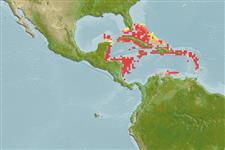Teleostei (teleosts) >
Pleuronectiformes (Flatfishes) >
Cynoglossidae (Tonguefishes) > Symphurinae
Etymology: Symphurus: Greek, syn, symphysis = grown together + Greek, oura = tail (Ref. 45335).
Environment: milieu / climate zone / depth range / distribution range
Ecology
Marine; demersal; depth range 1 - 27 m (Ref. 26268). Tropical; 27°N - 10°N, 89°W - 60°W (Ref. 26268)
Western Central Atlantic: Widespread through insular regions of the Caribbean Sea, including Glover's Reef, St. Eustatius, St. Barthelemy, and the French West Indies. Rarely captured along the continental margins of the Caribbean.
Length at first maturity / Size / Weight / Age
Maturity: Lm ?, range 3 - ? cm
Max length : 4.3 cm SL male/unsexed; (Ref. 53028); 5.7 cm SL (female)
Short description
Morphology | Morphometrics
Dorsal
soft rays
(total): 76-77;
Anal
soft rays: 61 - 62. Slender, small; pale with distinct, dark ocellated spots near rear of dorsal and anal fins.
Inhabits sandy substrates, also those submerged beds of aquatic vegetation, in clear shallow waters near coral reefs. Little is known of its biology since its captured infrequently and generally in small numbers; most captures were a single fish (Ref. 26268).
Life cycle and mating behavior
Maturity | Reproduction | Spawning | Eggs | Fecundity | Larvae
Böhlke, J.E. and C.C.G. Chaplin, 1993. Fishes of the Bahamas and adjacent tropical waters. 2nd edition. University of Texas Press, Austin. (Ref. 5521)
IUCN Red List Status (Ref. 130435)
Threat to humans
Harmless
Human uses
Fisheries: of no interest
More information
Age/SizeGrowthLength-weightLength-lengthLength-frequenciesMorphometricsMorphologyLarvaeLarval dynamicsRecruitmentAbundanceBRUVS
ReferencesAquacultureAquaculture profileStrainsGeneticsElectrophoresesHeritabilityDiseasesProcessingNutrientsMass conversion
Tools
Can't connect to MySQL database fbquizv2. Errorcode: Too many connections
